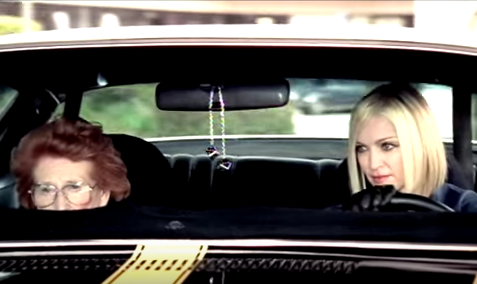In 2001, Madonna was still riding high on the wave of the release of her eighth studio album, Music. Though it came out on September 18, 2000, the video for “What It Feels Like For A Girl,” directed by then-love, current nemesis Guy Ritchie, resuscitated a conversation about the record.
Saturated with Ritchie’s particular brand of “laddish” imagery throughout the four minute, thirty second video, we’re bombarded with a dual message about the nature of womanhood: 1) you’re put out to pasture as soon as you appear sexually dried up and 2) only a female version of Death has the balls to come and actually put you in said pasture.
As Madonna prepares herself for a joy ride to the Ol Kuntz Guest Home (markedly, not “Rest Home”–as though to play up the concept that the old woman is a mere guest in the home we call sexual desirability), she dons an earring that says “LADY” and hastily packs a suitcase to put in her car. Before Tarantino’s “Pussy Wagon,” there is Madonna’s “Pussy… Cat” personal license plate on the yellow sports car she rides to pick up her target–this woman is clearly not her grandmother.
In fact, everything about the old woman screams, “This is my last hurrah,” with Madonna playing the Death role in a post-modern ode that reinvents the faceless male version by transforming him into a debauchery-loving girl who wants to take her “charge” out to see the best the world has to offer the way a youthful person would.
As dusk turns to night, the duo finds themselves at a stoplight. Leering men in the car next to Madonna and the old woman present the former with the opportunity to claim vengeance for all the times the latter was forced to put a lid on it while gawked at, especially back in the prime of her life, presumably sometime in the 50s and 60s. After winking at the bobbing headed men, Madonna guns the vehicle and then turns it around to smack right into them–she has quelled the representation of every man who ever made the old woman feel inferior with the mere look of lechery. And yet, they say a woman is invisible once she gets those first few wrinkles and men stop acknowledging her in any capacity, since the only reason to would be for sexually initiating purposes.
Madonna’s next act in the role of Death/feminist extraordinaire standing up for discarded old women everywhere is to Taser a man getting money out of an ATM and steal his, ahem, wad. The symbolism in this act stems from the notion that women are reliant upon men for money, financial well-being. But to simply take it from him, as though this is the extent of all he’s worth, exhibits that Madonna knows the true value of a woman does not derive from the money she can take possession of, but how she chooses to do so.
The next pair of men Madonna aggravates includes policeman who become irritated when she sideswipes their car at a drive-in (also an emblematic homage to the old woman’s heyday) and then threatens them with a gun that spurts out water into their faces, possibly a reference to the disappointment of a man’s own “gun.”
Smiling with diabolical pleasure, Madonna continues on her rampage through a team of recreational nighttime hockey players that run for cover as her car barrels through their game. She enjoys eating the rest of her fries from the drive-in (a gesture that makes sense when considering the song was written while she was pregnant with Rocco Ritchie, and succumbed to the temptations of cravings) as she nearly injures a few more men, making sure to stop in front of a trash can to deposit her refuse, iterating the point that women are still always careful and considerate in their recklessness.
As the video draws to a close and Madonna transitions the old woman into a different car upon stopping at a gas station and stealing an unsuspecting man’s while he’s distracted at the pump, the buildup to the final self-destruction mounts. Madonna has shown the old woman enough of a good time now, and the moment has come to end her life as she acts the part of Death, emphasized by the smash cut image of her slamming her hotel door shut and the numbers on the door shifting from 669 to 666, the mark of the beast, the devil, Death, whatever you want to call him. She must bring the old woman’s life to a close in one grand finale.
But more than that, Madonna as Death accents the point that when you’re day old bread as a woman, it is a form of death in our society. The fact that Madonna completed the song before giving birth to her second child highlights her own constant fear of irrelevancy, and being deemed not worthwhile simply because she is of a certain age.
And yes, sure, we’ve come a long way in the world of female “acceptance.” As Madonna noted at the time, “Our generation certainly has been encouraged to grab life by the balls, be super-independent, get a great education, follow our dreams, kick ass, all that stuff…” But there is a tradeoff that no one tells you about, the price you have to pay for doing all the things a man is allowed to do without incident. Madonna concluded of the message behind the song, “…and I feel like I woke up one day holding the golden ring and realized that smart, sassy girls who accomplish a lot and have their own cash and are independent are really frightening to men. I felt like, ‘Why didn’t somebody tell me? Why didn’t somebody warn me?’ And that’s also what that song is about–swallowing that bitter pill.” For some women, getting old helps to swallow it, because no one wants your mouth near them anyway.



















